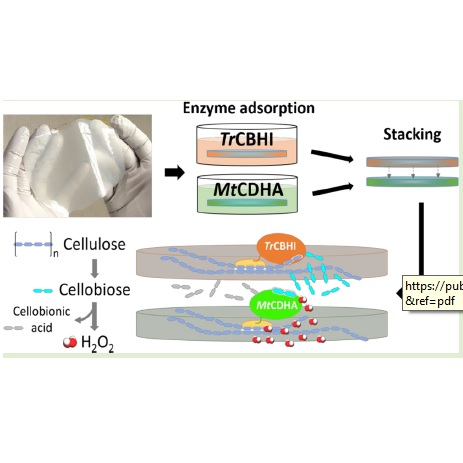Multienzyme cellulose films as sustainable and self-degradable hydrogen peroxide-producing material.
CALIFANO, Davide; KADOWAKI, Marco Antonio Seiki; CALABRESE, Vincenzo; PRADE, Rolf Alexander; MATTIA, Davide; EDLER, Karen J.; POLIKARPOV, Igor; SCOTT, Janet L.
CALIFANO, Davide; KADOWAKI, Marco Antonio Seiki; CALABRESE, Vincenzo; PRADE, Rolf Alexander; MATTIA, Davide; EDLER, Karen J.; POLIKARPOV, Igor; SCOTT, Janet L.




 Abstract: The use of hydrogen peroxide-releasing enzymes as a component to produce alternative and sustainable antimicrobial materials has aroused interest in the scientific community. However, the preparation of such materials requires an effective enzyme binding method that often involves the use of expensive and toxic chemicals. Here, we describe the development of an enzyme-based hydrogen peroxide-producing regenerated cellulose film (RCF) in which a cellobiohydrolase (TrCBHI) and a cellobiose dehydrogenase (MtCDHA) were efficiently adsorbed, 90.38 ± 2.2 and 82.40 ± 5.7%, respectively, without making use of cross-linkers. The enzyme adsorption kinetics and binding isotherm experiments showed high affinity of the proteins possessing cellulose-binding modules for RCF, suggesting that binding on regenerated cellulose via specific interactions can be an alternative method for enzyme immobilization. Resistance to compression and porosity at a micrometer scale were found to be tunable by changing cellulose concentration prior to film regeneration. The self-degradation process, triggered by stacking TrCBHI and MtCDHA (previously immobilized onto separate RCF), produced 0.15 nmol/min·cm2 of H2O2. Moreover, the production of H2O2 was sustained for at least 24 h reaching a concentration of ~2 mM. The activity of MtCDHA immobilized on RCF was not affected by reuse for at least 3 days (1 cycle/day), suggesting that no significant enzyme leakage occurred in that timeframe. In the material herein designed, cellulose (regenerated from a 1-ethyl-3-methylimidazolium acetate/dimethyl sulfoxide (DMSO) solution) serves both as support and substrate for the immobilized enzymes. The sequential reaction led to the production of H2O2 at a micromolar-millimolar level revealing the potential use of the material as a self-degradable antimicrobial agent.
Abstract: The use of hydrogen peroxide-releasing enzymes as a component to produce alternative and sustainable antimicrobial materials has aroused interest in the scientific community. However, the preparation of such materials requires an effective enzyme binding method that often involves the use of expensive and toxic chemicals. Here, we describe the development of an enzyme-based hydrogen peroxide-producing regenerated cellulose film (RCF) in which a cellobiohydrolase (TrCBHI) and a cellobiose dehydrogenase (MtCDHA) were efficiently adsorbed, 90.38 ± 2.2 and 82.40 ± 5.7%, respectively, without making use of cross-linkers. The enzyme adsorption kinetics and binding isotherm experiments showed high affinity of the proteins possessing cellulose-binding modules for RCF, suggesting that binding on regenerated cellulose via specific interactions can be an alternative method for enzyme immobilization. Resistance to compression and porosity at a micrometer scale were found to be tunable by changing cellulose concentration prior to film regeneration. The self-degradation process, triggered by stacking TrCBHI and MtCDHA (previously immobilized onto separate RCF), produced 0.15 nmol/min·cm2 of H2O2. Moreover, the production of H2O2 was sustained for at least 24 h reaching a concentration of ~2 mM. The activity of MtCDHA immobilized on RCF was not affected by reuse for at least 3 days (1 cycle/day), suggesting that no significant enzyme leakage occurred in that timeframe. In the material herein designed, cellulose (regenerated from a 1-ethyl-3-methylimidazolium acetate/dimethyl sulfoxide (DMSO) solution) serves both as support and substrate for the immobilized enzymes. The sequential reaction led to the production of H2O2 at a micromolar-millimolar level revealing the potential use of the material as a self-degradable antimicrobial agent. @article={003013177,author = {CALIFANO, Davide; KADOWAKI, Marco Antonio Seiki; CALABRESE, Vincenzo; PRADE, Rolf Alexander; MATTIA, Davide; EDLER, Karen J.; POLIKARPOV, Igor; SCOTT, Janet L.},title={Multienzyme cellulose films as sustainable and self-degradable hydrogen peroxide-producing material},journal={Biomacromolecules},note={v. 21, n. 12, p. 5315-5322},year={2020}}
@article={003013177,author = {CALIFANO, Davide; KADOWAKI, Marco Antonio Seiki; CALABRESE, Vincenzo; PRADE, Rolf Alexander; MATTIA, Davide; EDLER, Karen J.; POLIKARPOV, Igor; SCOTT, Janet L.},title={Multienzyme cellulose films as sustainable and self-degradable hydrogen peroxide-producing material},journal={Biomacromolecules},note={v. 21, n. 12, p. 5315-5322},year={2020}}